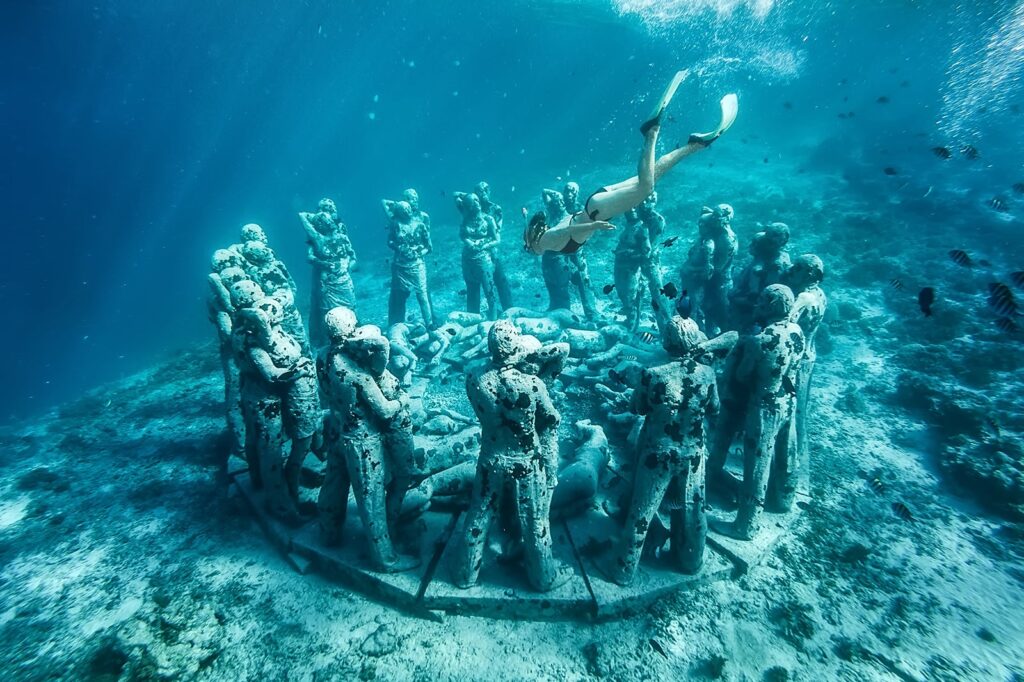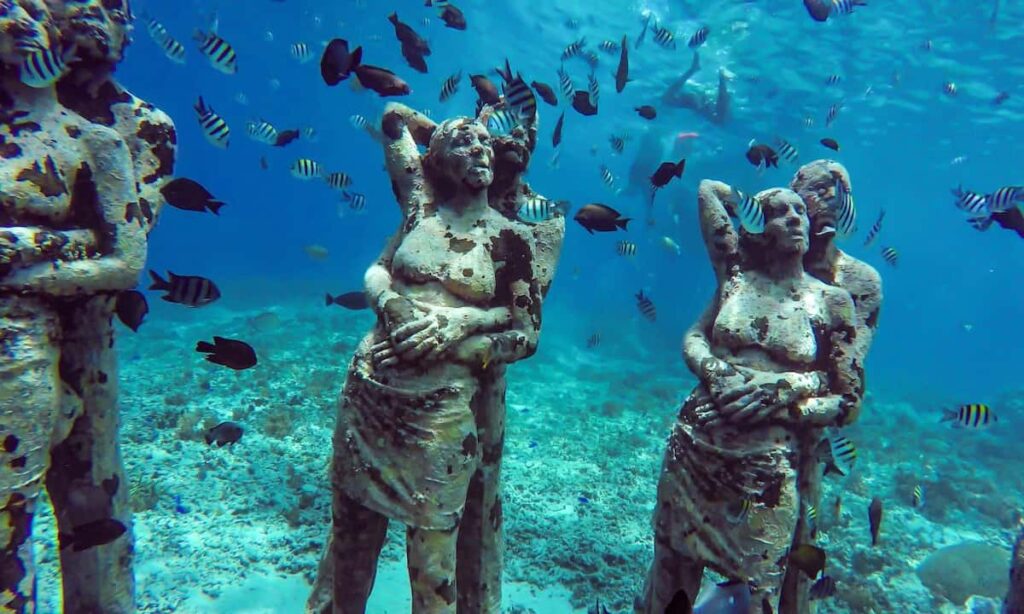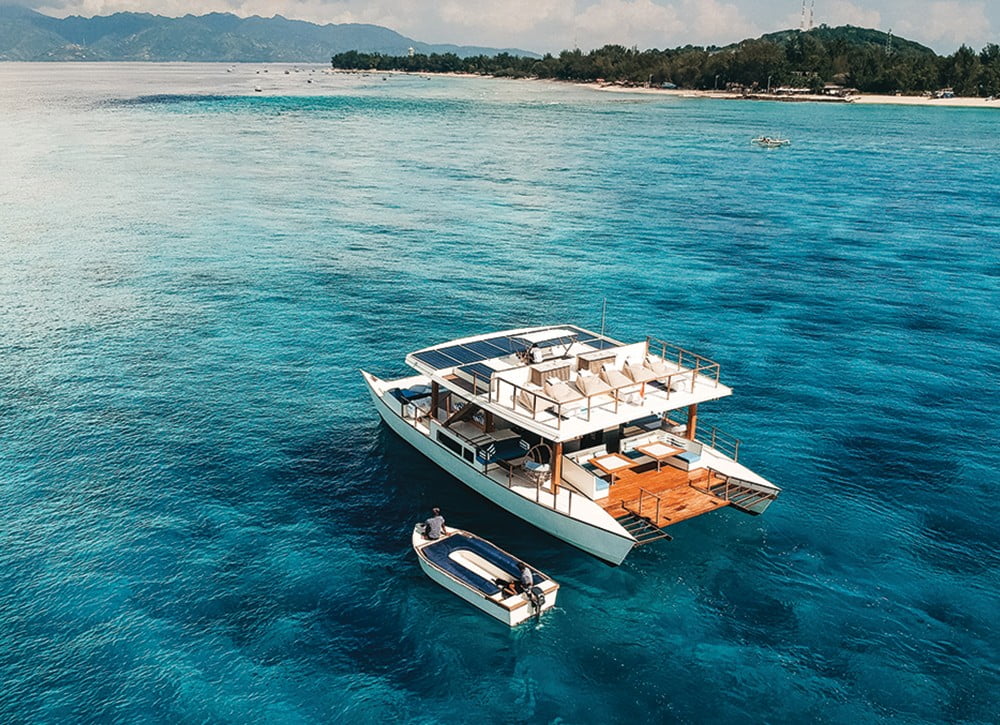Among many wonders in Indonesia, Gili Meno is deemed to be one of the exceptional hidden gems that should be visited once in your lifetime. This island is the smallest of the three Gili Islands, offering an ideal setting for those yearning for a desert-island fantasy. Surrounded by stunning coastlines and vibrant coral reefs, it distinguishes itself as the most serene and culturally rooted island of the three. Gili Meno is a cherished destination primarily embraced by honeymooners and discerning travellers.

Along with its pristine water and panoramic landscape, you’ll find the mystical life-sized statues of couples arranged in a circle with their various embracing and reclining poses that grace the island. These statues are famously known as the Gili Meno statues, crafted by a renowned underwater artist.
The Allure of Gili Meno Statues Story
The Gili Meno statues, described as “hauntingly beautiful,” have rapidly become a popular destination for snorkelling and diving. Commissioned by BASK, the eco-resort where the statues are situated, the project named “Nest” was crafted by the British sculptor Jason deCaires Taylor. A circle of 48 life-size statues, symbolising life and continuity, adorns the ocean floor. Embracing figures surround curled-up statues in this underwater display. Notably, each statue is crafted from casts of real individuals, adding a unique touch to the sculptures.
Jason deCaires Taylor, a well-known underwater sculptor, has placed his artistic mark, multiple human-made reefs, in the shallow waters in various locations around the world, including the Canary Islands, Mexico, West Indies, and even a temporary exhibit in the Thames in London. Beside being a great photography site, Nest is initially designed to provide a habitat for coral, facilitating the formation of a stunning man-made reef.

Exploring Gili Meno Statues Meaning
The Gili Meno statues hold a profound significance since they aim to foster coral growth and establish a reef for marine life.
deCaires Taylor himself once said about Gili Meno statues meaning that primarily, Nest serves as an environmental space. The circular arrangement of the figures echoes the circle of life, and it is anticipated that life will thrive within them. The rapid flourishing of soft corals and sponges is expected to pave the way for the growth of delicate hard corals. It is also expected that the statues will transform into a fully established reef as a food source for fish.
The Craftsmanship behind Gili Meno Statues
Nest serves as an ecological sanctuary, specifically designed to provide a habitat for coral. The ecosystem of coral reefs has been globally declined, including Indonesia’s diverse reefs. The destruction of coral reefs in the Gili Islands, worsened by the 2018 earthquake and illegal anchoring, adds to the broader issue. Human-induced factors like pollution, overfishing, and climate change are the primary contributors to coral bleaching and mortality worldwide.
Nest becomes a stable platform for marine life, made from pH neutral, environmentally-friendly concrete and securely anchored to the seabed. The statues are anticipated to help create a manmade reef where coral can grow and evolve into a fully-established reef over time. Initially, soft corals and sponges will colonise these structures, creating a foundation for the thriving of diverse marine life. Presently, Nest already attracts various marine species, including fish and sea turtles. Installations like Nest not only contribute to the preservation of reefs globally but also draw attention from tourists, fostering awareness about the crucial need to safeguard reefs.
Thus that’s the reason we are prohibited from touching the statues because coral and sponges are starting to grow on them. Touching the statues prevents them from growing coral and doing the work they’ve been designed to do.
How to Get to Gili Meno Statues
Taking a boat is the most convenient way to go to Nest for those staying in Gili Trawangan. You can try taking one of the daily local boats departing from Gili Trawangan to Gili Meno and Gili Air if you’re on a tight budget. These boats leave at 9:30 a.m. and 4 p.m., with tickets costing IDR 35,000 for Trawangan to Meno and IDR 40,000 for Trawangan to Air. Return trips from Meno to Trawangan are available daily at 8:50 a.m. and 3:20 p.m. If you plan for a day trip, catch the 9:30 a.m. boat from Gili Trawangan and return on the 3:20 p.m. boat, sparing you approximately 5.5 hours for exploration.
Starting from the Gili Meno port, a 15–20 minute walk will take you to Bask Resort. Alternatively, you can rent bicycles near the port for island exploration. From Bask Resort, you can swim out to Nest, which is around 100 metres from the beach in mostly shallow waters. The statues themselves are at a depth of about 4 metres, making the site accessible to both divers and snorkelers.

To make a day of it, you can take a five-hour cruise with us that not only includes a visit to the Nest Underwater Statues but also takes you to other fantastic snorkelling locations. This once in a lifetime trip provides a comfortable experience aboard our 16 metre catamaran with snorkel guides and premium snorkel equipment. You’ll also enjoy a gourmet food buffet and a free flow drinks package that includes beer, wine and craft cocktails. You can pick between two of our cruises, one in the morning and one in the afternoon – they offer different experiences, yet the same exceptional service and fantastic vibe.

